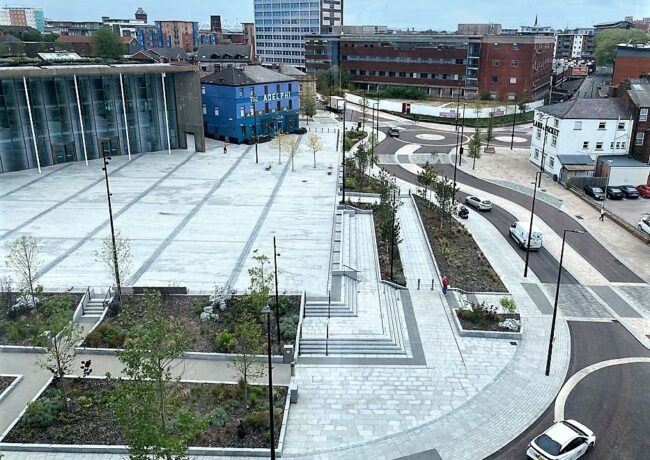Sustainable drainage systems to become mandatory
The Department for Environment, Food, & Rural Affairs will begin a consultation regarding how to implement the new policy, with the expectation for sustainable drainage systems to become a requirement for new developments beginning in 2024.
SuDS are a nature-based solution to drainage problems. SuDS can vary from installing permeable surfaces to creating rain gardens to building attenuation ponds. Whichever method is used, SuDS will capture water and then filter that water slowly into the ground. Benefits of SuDS include keeping water from mixing with sewage, improving biodiversity, and easing pressure on current drainage systems – all while absorbing carbon.
The quality of future SuDS would be evaluated by a SuDs approving body, which the government has nicknamed SAB.
The decision to make SuDS mandatory by 2024 was announced in by DEFRA yesterday in a review document of recommendations for the implementation of Schedule 3 to The Flood and Water Management Act 2010.
The news of a SuDS requirement for future development has been met with positivity by North West engineers.
Lisa Sawyer, director of civil engineering at Chester-based Land Studio, said she was delighted by the decision, describing SuDS as a way to provide “not just storage or conveyance features, but bring multi-functional qualities with amenity and biodiversity in mind.”
Sawyer said that Land Studio has been including SuDS in more and more of its projects across the UK.
“We’re also working with a growing number of housing developers who want to ensure that water management solutions are integrated into their designs from early-stage concept,” Sawyer said.
Stephen O’Malley, chief executive of Manchester-based Civic Engineers, echoed Sawyer’s approval, calling the government’s decision “an important step forward in protecting our environment, addressing climate change, and improving public health.”
He continued: “Using nature-based solutions, such as SuDS is crucial as it improves climatic resilience in the face of increased risk of flooding and extreme temperature. These techniques also work with the prevailing geography of a place and sensitively apply help to strengthen its best qualities, enhancing amenity, and making places greener and more attractive.
“As engineers, we champion a nature-based approach wherever we can as we have a vital role to play in shaping the landscape to ensure our infrastructure meets our ever-changing, more complex needs,” he said.
“We hope that mandating SuDS in new developments is just the start. If we can roll out well-designed projects, founded on nature-based solutions, hopefully, we will be able to gather the evidence that demonstrates their benefits so confidence, skills, supply chains, and wider systems grow and ultimately this approach expands to retrofitting SuDS too.”
Emma Keegan, associate director of flood risk at environmental and engineering consultancy Wardell Armstrong, said that the government’s plan should provide a clear and consistent approach to SuDS.
“If similar processes and procedures are put in place for England as in Wales, as recommended by the review, it will provide developers with clear guidance on the requirements for approval and guarantee that SuDS will be adopted and maintained to the national standards for their lifetime,” she said.
Keegan acknowledged that change can take time.
“There will of course be an initial period of adjustment for local authorities and developers, and it may well mean that a more detailed level of design is required earlier in the planning and approval process than some developers have been used to, especially if SuDS approving body approval and planning approval are applied for consecutively,” she said.
“It will be crucial for the SAB and local planning authority to work closely together, and for developers to fully understand the interrelationships between relevant local planning policies and any forthcoming Statutory SuDS Standards, to ensure their drainage designs meet the requirements of both.”
Martin Dyer, director of environmental consultancy E3P, also reflected on the SuDS approving body, noting that SAB was “the missing piece of the drainage jigsaw”.
“This will lead to significant environmental benefits for residents in both new and existing communities,” he said. “The wider use of SuDS is expected to provide significant benefit to water quality, ecosystems, and biodiversity.”
Jacq Whitworth-Allan, associate director of landscape architecture at LUC’s Manchester office, described SuDS as “absolutely fundamental to mitigating the impact of flooding”.
For those concerned about yet another planning requirement, Whitworth-Allan said that SuDS can offer powerful benefits to a project.
“This decision from DEFRA isn’t something for the North West property market to fear,” she said. “Incorporating trees, rain gardens and swales makes a significant contribution towards creating characterful, distinctive places and streets where people will want to live, work and play, and where nature can thrive.”





Manchester Council quickly googling what SUD is because they’ve spent the last 10 years ignoring them, hence why the city’s pavements are flooded whenever it rains
By Anonymous
It is odd to see this being pushed for and promoted by what is ostensibly not a planning or building regulations focussed department, rather than, y’know, the actual relevant department.
I’m old enough to recall that maybe 10+yrs ago that the requirement and provision of SuDS was to be within the control of Building Control, which makes sense as it is a largely technical exercise rather than a determining factor as to the location and type of development (critical drainage areas notwithstanding). Some Councils had set up specific teams in their Building Control groups to deal with this but then it was quietly shelved and, as with most things, moved over to planning to deal with.
As a planner I’d be quite happy if it was taken away into approved documents, in the same way that contaminated land should be solely a building regs issue and not a planning one because we are seemingly becoming the body that deals with anything and everything related to development.
By JohnMac
SuDS is already mandatory via the planning process, this is not news. It’s already impossible to get schemes through planning permission or discharge of conditions without satisfying UU or the LLFA who place increasingly onerous requirements on developers and consultants. Where schemes have every intention of implementing SuDS as part of the development, gaining approval is obstructive and it is necessary to provide almost construction level civils design at planning stage, rather than conditioning requirements and dealing with it during the normal design development process.
By Anonymous
All we will then need, will be the staff within the LPA’s to deal with these in a timely, effective and competent manner through the planning process. Fingers crossed and good luck to them but I’m not holding my breath for all 3! More pain in the meantime for all involved in the planning process.
By Ste P
Google the West Gorton “Sponge” Park and the new Mayfield Park if you want to see what Manchester City Council has been doing with SUDS over the last few years.
By Anonymous
Don’t really understand the fuss. Suds is essentially already mandated through planning. BTW, pavements flooding is down to maintenance, not the presence or a sense of suds.
By Peter Black